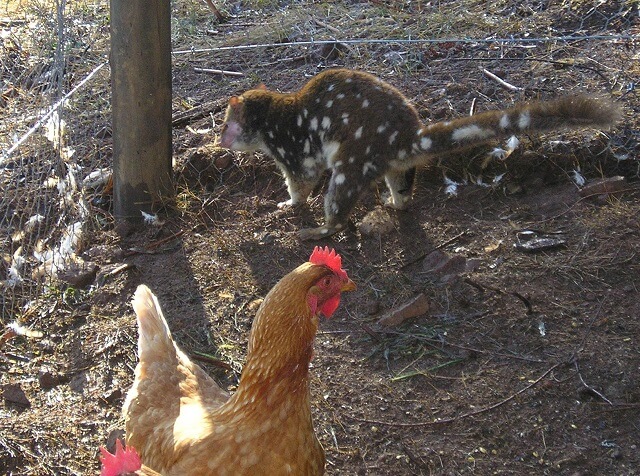The spotted-tailed quoll is the Australian mainland’s largest carnivorous marsupial and is listed as a threatened species in all areas where it occurs across Australia.
In New South Wales, spotted-tailed quolls mainly live in forests and woodlands of the slopes and ranges of the Great Divide and on coastal escarpments and plains. Quolls typically move along creek lines to hunt for gliders, possums, bandicoots, rats, birds and lizards. They use hollow logs, rocky outcrops and crevices to shelter and raise their young.
While the quolls' natural habitat is the forest, they have learnt to travel across open country and, with home ranges of up to 3,000 hectares, they can turn up almost anywhere. Recent road kill sightings of quolls in urban Canberra and Wollongong show their capacity to search far and wide for food. This means that, no matter where you live, if you have chooks you’re very likely to have a quoll check them out at some point.
Historically, quolls were treated as pests and were trapped, shot or poisoned by people protecting their chooks. Occasionally, quolls died from injuries sustained from trying to enter or exit chook pens. These practices have contributed to a decline in quoll numbers, and quolls are now listed as a threatened species in New South Wales.
To help enjoy the experience of quolls visiting your property and have peace of mind about the welfare of your prized hens, we’ve pulled together a few tips to help you quoll-proof your hen house, including quoll-proof designs. Quoll-proofing your hen house also keeps out other predators and egg thieves, such as foxes, dogs, goannas, pythons and ravens.
What can I do if quolls visit my hen house?
Trapping quolls is illegal and can be dangerous for both animals and humans. Quolls can harm themselves trying to escape from traps and females can drop their young from their pouches. It may not be safe for the trapper either, as quolls have extremely sharp claws and powerful jaws.
If you suspect or see a quoll visiting your hen house, please contact your Local Land Services or National Parks and Wildlife Service office. They may be able to help you with a motion camera to identify the species or help you safely trap and relocate the animal.
Know your tracks
Is a predator visiting your hen house? Tracks and prints can help identify who the culprit may be – see Protect your chooks and save our quolls for the difference between quoll, fox and dog tracks.
Alternatively, consider using a wildlife surveillance camera to photograph the predator. You can find these online.

Design your poultry pen to keep predators out, not just to keep your chickens in.
Protection of native animals
All native birds, reptiles, amphibians and mammals, but not including dingoes, are protected in New South Wales by the Biodiversity Conservation Act 2016.